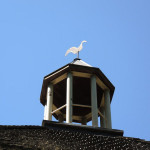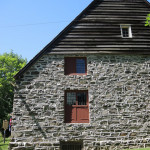On my way back from Poughkeepsie, I stopped in New Paltz to visit Historic Huguenot Street, which popped up on my twitter feed on Sunday evening. Once I arrived, I realized I’d been there once during my college career, but only to wander around outside, never in the buildings, and moreover they’re in the process or renewing their interpretation.
One interpretive choice they’ve made is to pair two 18th century houses. One is unfurnished, so you can see the architectural features and the way the construction progressed over time. The other house is fully furnished with pieces that are (mostly) appropriate to the period interpreted. Our guide was explicit about the comparison, particularly when we were in the basement kitchens of the two houses. In the unfurnished house, the kitchen felt smaller, there was less natural light and little artificial light, and the overall feeling was depressing. The kitchen in the furnished house had more light, natural and artificial, and seemed almost cheerful in comparison. However, our guide reminded us that the space would have been smoky and smelly, and that in the 18th century the people working in the kitchen would have been enslaved African Americans.
I appreciated the contrast as part of an overall effort by the site to make the act of interpretation transparent. Both guides I had explicitly stated “we have decided to interpret” and we were even asked if we thought the comparison of furnished and unfurnished was helpful. When I was working in a historic house in Virginia, we often talked about whether to interpret areas for which we had little or no documentation, in particular the upstairs bedchambers. Do you fully furnish a house, even without evidence? Or leave rooms empty, knowing that visitors often expect to see “what it was like”? And if you are guessing, what do the guides/docents tell the visitors? Historic Huguenot Street has the advantage of having multiple houses, but they could have chosen to interpret them all one way or the other. I think the decision to show the two paths interpretation can take, and in sequence, not only helps visitors think about the past but also how the past is presented to them at historic sites.
I look forward to returning for a more leisurely visit the next time I’m in the area. I’m curious to interact with the first person interpreters, and see where else the education and interpretation goes. My experience was a little off the usual, because I had a guide for all of the houses, when some of them usually have first person interpretation (they started the tour a little early for me since I had to drive back to Virginia).


